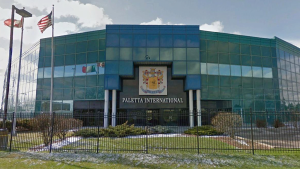To clear the way for another glassy addition to the Toronto skyline, two structures built to honour a pair of iconic Canadian doctors have been demolished.
The Banting and Best Department of Medical Research, known as the Banting and Best building at 112 College St., were taken down by Priestly Demolition over the winter.
In its place two trapezoid glass towers will rise, the Schwartz Reisman Innovation Centre, designed by New York-based Weiss/Manfredi Architects in collaboration with Teeple Architects of Toronto.
The buildings are not the University of Toronto labs where doctors Frederick Banting and Charles Best discovered insulin in 1923 but were erected in 1951 to 1954 in their honour. Banting worked with newly graduated Best in Professor John Macleod’s labs in the 1920s to find a cure for diabetes, as a diagnosis at the time was a death sentence. James Collip eventually worked with them to perfect a process of extracting insulin from animal pancreases. Banting and Macleod won a Nobel Prize for their work in 1923.
The innovation centre will bring 750,000 square feet to the University of Toronto to replace the 50,000 square feet of the Banting and Best buildings.
“They were two buildings joined by a bridge,” says Brian Priestly, vice-president of operations at the family business. “That we had to take down by hand. We had to expose the steel by chipping away at the bricks and then cut the steel with a torch.”
In fact, the demolition of the four-storey brown brick structures was full of challenges for what is a relatively small project, compared to some Priestly has tackled over the decades.
“SickKids was probably more of a logistical challenge,” says Priestly. “But this one was very labour intensive.”
The interior floors were too weak to support machinery so only small Bobcats could be used sparingly. The unexpected discovery of asbestos led to the demolition being shut down while it was abated.
Work resumed around Christmas 2019 and wrapped in early March of this year, but the company will be back this summer to take out the foundations once the caissons have been placed.
“We had to chip away all the terracotta and other masonry by hand,” he says. “We took hundreds of tons of masonry rubble out and down to the lake. But getting vehicles and trailers in and out was also a challenge.”
The site is on the east side of College Street at University, smack dab at the head of Hospital Alley at the crossroads of the University of Toronto’s corridor of buildings. It’s packed with traffic, people and transit and as such is another one of those inner city sites where logistics play a huge role.
With the advent of new transit lines across Eglinton Avenue, plans are already in motion to demolish and replace a lot of the 1950s and 1960s mid and low rises across the Yonge and Eglinton area which will mean a lot of more tight site locations and logistical challenges for both demolition and reconstruction.
“There’s also a daycare to the north of the site at the Ministry of Infrastructure building, so we had to build a canopy there and we couldn’t move trucks in and out or do some work during certain hours because of the kids. We had five people just to direct traffic when the trucks were moving because we didn’t want to disrupt transit,” Priestly says. “And we had to keep the dust down because of the kids and the location, so lots of water for dust suppression.”
They did manage to get a Volvo 700 excavator into the location, which is also fitted with a dust suppression system, he adds.
As of March, the buildings were razed to the foundations at ground level and the two level basement backfilled with aggregate so that construction crews can move into stable ground and start sinking their caissons for the new building.
“Once they’re done with the caissons they’ll pull out the aggregate and we’ll move in to take the foundations out,” says Priestly.







Recent Comments
comments for this post are closed